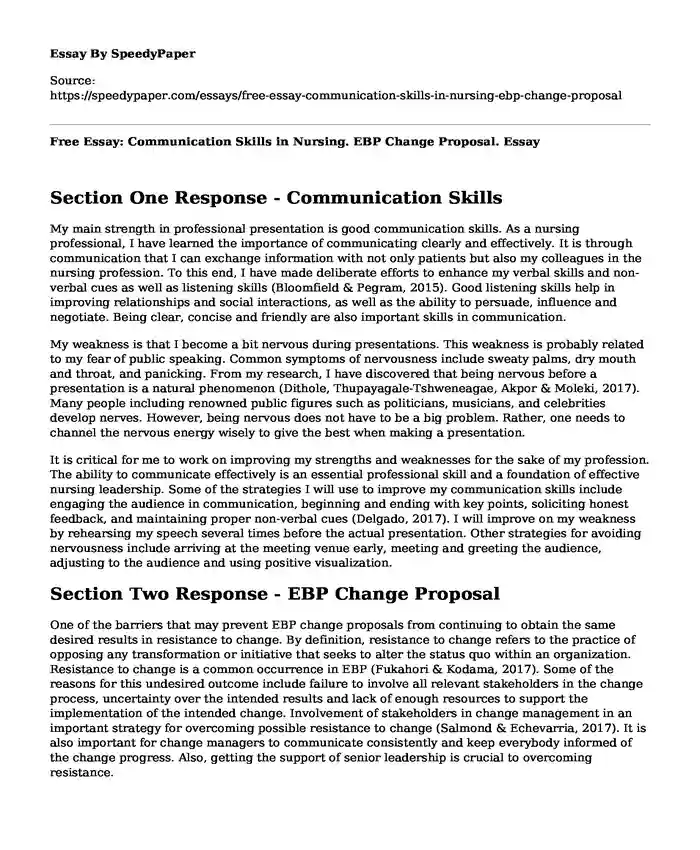
| Type of paper: | Essay |
| Categories: | Nursing management Communication skills |
| Pages: | 3 |
| Wordcount: | 707 words |
Section One Response - Communication Skills
My main strength in professional presentation is good communication skills. As a nursing professional, I have learned the importance of communicating clearly and effectively. It is through communication that I can exchange information with not only patients but also my colleagues in the nursing profession. To this end, I have made deliberate efforts to enhance my verbal skills and non-verbal cues as well as listening skills (Bloomfield & Pegram, 2015). Good listening skills help in improving relationships and social interactions, as well as the ability to persuade, influence and negotiate. Being clear, concise and friendly are also important skills in communication.
My weakness is that I become a bit nervous during presentations. This weakness is probably related to my fear of public speaking. Common symptoms of nervousness include sweaty palms, dry mouth and throat, and panicking. From my research, I have discovered that being nervous before a presentation is a natural phenomenon (Dithole, Thupayagale-Tshweneagae, Akpor & Moleki, 2017). Many people including renowned public figures such as politicians, musicians, and celebrities develop nerves. However, being nervous does not have to be a big problem. Rather, one needs to channel the nervous energy wisely to give the best when making a presentation.
It is critical for me to work on improving my strengths and weaknesses for the sake of my profession. The ability to communicate effectively is an essential professional skill and a foundation of effective nursing leadership. Some of the strategies I will use to improve my communication skills include engaging the audience in communication, beginning and ending with key points, soliciting honest feedback, and maintaining proper non-verbal cues (Delgado, 2017). I will improve on my weakness by rehearsing my speech several times before the actual presentation. Other strategies for avoiding nervousness include arriving at the meeting venue early, meeting and greeting the audience, adjusting to the audience and using positive visualization.
Section Two Response - EBP Change Proposal
One of the barriers that may prevent EBP change proposals from continuing to obtain the same desired results in resistance to change. By definition, resistance to change refers to the practice of opposing any transformation or initiative that seeks to alter the status quo within an organization. Resistance to change is a common occurrence in EBP (Fukahori & Kodama, 2017). Some of the reasons for this undesired outcome include failure to involve all relevant stakeholders in the change process, uncertainty over the intended results and lack of enough resources to support the implementation of the intended change. Involvement of stakeholders in change management in an important strategy for overcoming possible resistance to change (Salmond & Echevarria, 2017). It is also important for change managers to communicate consistently and keep everybody informed of the change progress. Also, getting the support of senior leadership is crucial to overcoming resistance.
Another major barrier is alterations in managerial personnel. When new persons are introduced to management, they may bring their ideas and ways of working in the organization. As a result, informal relationships may change, necessitating the entire organization to change accordingly. This can affect the EBP change proposal (Spiva, Hart, Patrick, Waggoner, Jackson & Threatt, 2017). Frequent change of management personnel may be an indication of a deficiency in the organization. These deficiencies may be in the form of poor coordination between various departments, an unmanageable span of control, a multiplicity of roles and lack of cooperation between lines and staff.
References
Bloomfield, J. & Pegram, A. (2015). Care, Compassion and Communication and communication. Nursing Standard, 29(25), 45-50. DOI: 10.7748/ns.29.25.45.e7653Delgado, S. A. (2017). Increasing Nurses' Palliative Care Communication Skills. American Journal of Critical Care, 26(5), 372-372. doi:10.4037/ajcc2017427
Dithole, K. S., Thupayagale-Tshweneagae, G., Akpor, O. A., & Moleki, M. M. (2017). Communication skills intervention: promoting effective communication between nurses and mechanically ventilated patients. BMC Nursing, 16(1). doi:10.1186/s12912-017-0268-5
Fukahori, H. & Kodama, Y. (2017). Nurse managers' attributes to promote change in their wards: a qualitative study. Nursing Open, 4(4), 209-217. https://doi.org/10.1002/nop2.87
Salmond, S. & Echevarria, M. (2017). Healthcare Transformation and Changing Roles for Nursing. Orthop Nurs, 36(1), 12-25. doi: 10.1097/NOR.0000000000000308
Spiva, L., Hart, P. L., Patrick, S., Waggoner, J., Jackson, C., & Threatt, J. L. (2017). Effectiveness of an Evidence-Based Practice Nurse Mentor Training Program. Worldviews on Evidence-Based Nursing, 14(3), 183-191. doi:10.1111/wvn.12219
Cite this page
Free Essay: Communication Skills in Nursing. EBP Change Proposal.. (2022, Aug 31). Retrieved from https://speedypaper.net/essays/free-essay-communication-skills-in-nursing-ebp-change-proposal
Request Removal
If you are the original author of this essay and no longer wish to have it published on the SpeedyPaper website, please click below to request its removal:
- Free Essay on the Letters by Abigail Adams - Remember the Ladies
- Freudian Defense Mechanism Essay Example
- Essay Sample: United States and the Refugees Crisis
- Notes over Supplementary Readings, Free Essay in History
- Free Essay Sample: War on Drugs and Minority
- Kafka's The Metamorphosis Analysis Free Essay
- The Victorious Youth Statute - Free Essay Example
Popular categories




